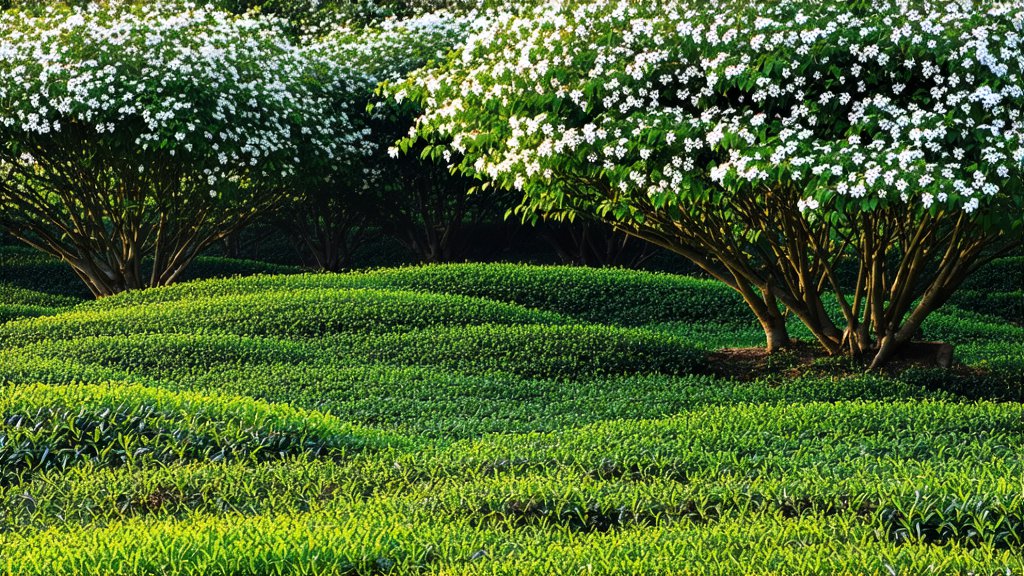
In the vast and diverse landscape of Chinese tea culture, White Peony Tea, known as Bai Mu Dan in Mandarin, stands out as a symbol of elegance, purity, and subtlety. This exquisite tea, hailing from the Fujian Province, has captivated tea enthusiasts for centuries with its delicate flavor profile and graceful appearance. As a distinguished variety within the broader category of white teas, White Peony Tea represents not only a beverage but also an art form deeply rooted in China's rich cultural heritage.
Historical Background
The origins of White Peony Tea trace back to the early Qing Dynasty (1644-1912), during which it was first produced in Fuding County, Fujian Province. It is said that this tea was initially created by accident when tea farmers left freshly harvested leaves to dry under the sun, leading to a natural oxidation process that gave birth to the unique characteristics of white tea. Over time, these serendipitous discoveries evolved into meticulous cultivation and processing techniques, solidifying White Peony's place among China's finest teas.
Varieties and Classification
White Peony Tea belongs to the 'Bai Hao Yinzhen' or 'Silver Needle' category, which encompasses premium white teas made solely from young tea buds and leaves. Unlike its more robust counterparts like green or black tea, white tea undergoes minimal processing, preserving its natural properties and resulting in a lighter color and flavor profile. Within the realm of white teas, White Peony strikes a perfect balance between the simplicity of Silver Needle and the complexity of寿眉 (Shou Mei), making it a favorite among connoisseurs seeking nuanced flavors without overwhelming intensity.
Cultivation and Production
The journey of a White Peony Tea leaf begins in the misty mountains of Fujian, where the climate, soil, and altitude create optimal conditions for tea cultivation. The tea bushes used for Bai Mu Dan are typically Camellia sinensis var. sinensis, known for their tender shoots and high levels of amino acids, contributing to the tea's sweetness and umami notes. Harvesting usually takes place in late spring, when the first flush of leaves is handpicked, ensuring only the youngest and most tender parts of the plant are selected.
The production process involves several intricate steps:
-
Withering: Freshly picked leaves and buds are spread thinly on bamboo mats or trays and left to wither under controlled temperature and humidity. This step allows moisture to evaporate slowly, softening the cell walls and preparing the leaves for further processing.
-
Fixed Oxidation: While withering, the leaves undergo a mild oxidation process, which enhances their natural sweetness and develops subtle floral aromas. Care must be taken to prevent over-oxidation, which would alter the tea's delicate character.
-
Shaking and Drying: After withering, the leaves are gently shaken to promote even drying and further oxidation. They are then dried either through sunlight or in specialized drying rooms until they reach the desired moisture content.
-
Sorting and Packaging: Once dried, the leaves are sorted by size and quality, removing any imperfections or foreign materials. The final product is carefully packaged to maintain freshness and protect against oxidation.
Appearance and Aroma
White Peony Tea is renowned for its beautiful appearance, characterized by slender, downy buds interspersed with dark green leaves. When brewed, the infusion reveals a pale yellow hue, reminiscent of a delicate jade or chrysanthemum petals soaked in water. The aroma is a harmonious blend of fresh florals, honeyed sweetness, and a whisper of fruitiness, inviting drinkers into a sensory experience that transcends the ordinary.
Tasting Notes and Appreciation
To fully appreciate the subtleties of White Peony Tea, one must engage in a mindful tasting ritual. Begin by selecting a transparent glass teapot or gaiwan to observe the unfurling leaves as they dance in hot water. Use water heated to around 80-85°C (175-185°F) to avoid scorching the delicate leaves. Steep for approximately 3-5 minutes, allowing the flavors to unfold gradually.
As you take your first sip, notice the silky texture that glides across your palate, followed by a gentle sweetness that lingers. The aftertaste is clean and refreshing, with hints of floral notes that evoke images of blooming orchids or cherry blossoms in springtime. Each subsequent infusion will reveal new dimensions of flavor, from a light vegetal essence to a deeper, more complex profile.
Health Benefits
Beyond its aesthetic pleasures, White Peony Tea offers numerous health benefits. Rich in antioxidants such as catechins and polyphenols, it helps combat free radicals, supports cardiovascular health, and may contribute to weight management. Its moderate caffeine content provides a gentle energy boost without the jitters associated with stronger teas or coffee. Additionally, regular consumption of white tea has been linked to improved skin health, enhanced immune function, and reduced risk of certain chronic diseases.
Cultural Significance
In Chinese culture, tea is not merely a drink; it embodies philosophy, art, and social harmony. White Peony Tea, with its ethereal qualities, perfectly embodies these principles. It is often served during important gatherings and ceremonies, symbolizing purity, respect, and the appreciation of life's simple pleasures. The act of preparing and sharing White Peony Tea fosters connections between individuals, strengthening bonds and promoting a sense of community.
In conclusion, White Peony Tea is more than just a beverage; it is a testament to the artistry and wisdom of Chinese tea culture. From its storied history and meticulous production methods to its enchanting aroma, flavor, and health benefits, this tea invites us to slow down, savor each moment, and find beauty in simplicity. As we continue to explore and celebrate the world of tea, let us remember the lessons embodied by White Peony Tea: that true elegance lies in understatement, and the most profound experiences often arise from the gentlest of things.